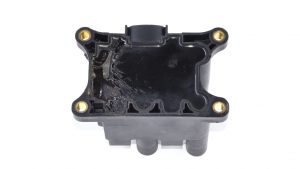sign our newsletter and stay on top of the latest news, offers and courses.
Coil terminal rubber degradation;
Coil rubber drying.
Misfire;
Flash over between spark plug and coil;
For Cause 1, perform preventive maintenance on the ignition system, replacing the components if the rubber shows dryness;
For Cause 2, check and correct any engine oil leaks;
For Cause 3, check any engine heating problems, correct if necessary;
For Cause 4, avoid the use of chemicals in engine washing.
for all cases, replace the ignition coil with the correct model, referring to the NGK application table.
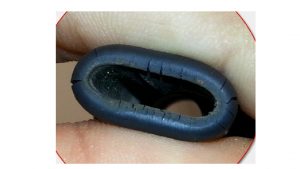

Coil has melting on electrical connector pins and/or coil melting.
Misfire;
Coil melting;
Smoke in the engine compartment;
For causes 1 to 3, replace vehicle harness connector.
For Cause 4, replace or repair vehicle harness. Use specific wires that support the supply current and temperature;
For Cause 5, check the coil supply current, too high supply current causes heating of wires and connector;
for all cases, replace the ignition coil with the correct model, referring to the NGK application table.
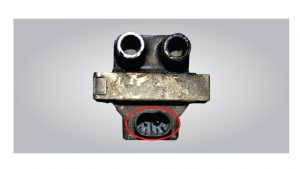

Sail: Dark vertical marks between terminal pin and metal castle, caused by the passage of electric current on the outside of the spark plug.
Cape: Vertical marks on the cable insulation rubber, caused by the passage of electric current.
Coil: Vertical marks on the coil insulation rubber or between the high voltage terminals, caused by the passage of electric current.
Misfires, especially at higher engine torque rotations, which can generate overflows in the intake manifold in case of CNG use.
Consumption increase;
Increased levels of pollutant emissions;
For Cause 1, replace candles, cables and coil simultaneously;
For Cause 2, clean your hands, avoiding oil residue, greases and solvents in ignition components;
For Cause 3, check the correct operation of the injection system;
For causes 4 and 5, follow the maintenance plan specified by the engine manufacturer. If you do not have the maintenance plan, the recommendation is to inspect every 10.000km and change every 3 years or 60.000Whichever comes first;
For Cause 6, check compression ratio or turbo pressure, correcting if necessary;
For Cause 7, in CNG systems (gas) and programmable injection system, check the correct ignition timing;
For Cause 8, replace the candles, cables and ignition coil by those specified in the NGK application table.


High voltage coil terminal or connector with oxidation.
Misfire;
High resistance in the secondary of the coil;
Excessive heating in the region of the terminals;
Melting the Wire Harness and Coil;
Rust of new cables or spark plug terminal pin.
For Cause 1, avoid the application of chemicals and/or solvents when washing engines.
For Cause 2, ensure a perfect connection between cable and coil and/or between spark plug and ignition coil. Replace ignition coils and ignition cable simultaneously, in the case of coils applied directly to the spark plug, replace spark plugs and ignition coils simultaneously;
for all cases, replace the coil, cables and spark plugs of the correct model, referring to the NGK application table.
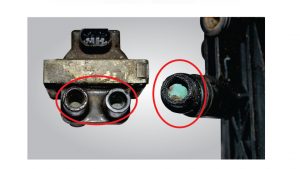

Melting epoxy resin, coil body deformation and coil overheating.
Misfire;
difficulty starting;
Coil Overheating - With Coil Overheating, smoke may occur, the coil material is self-extinguishing, that is, when cutting the coil power it does not ignite;
For Cause 1, replace the ignition coils with the correct type;
For causes 2 and 3, check the injection module command drive. There are two types of coils, with ignition module attached and without ignition module attached. If the coil has an ignition module, the injection module is responsible for sending a command signal to the coil, this signal must be checked for format and duration.. If the coil does not have an ignition module, the feed is commanded directly by the injection module, in this case, check the injection module command. If necessary, repair the injection module command drive;
For causes 4 and 5, check the food, coil grounding and electrical system grounding;
For Cause 6, check the dwell time and coil command signal if they are compatible with the applied coil;
For Cause 7, check spark plug wear, heavily worn spark plugs need more tension for sparking, increasing coil stress;
for all cases, replace the ignition coil with the correct model, referring to the NGK application table.
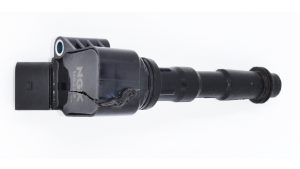
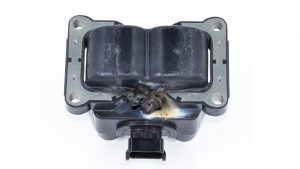

Breakage in the body region or high voltage tower.
electric current leakage;
Misfire;
Fixing difficulty.
For Cause 1, turn the cable to detach from the coil terminal;
For Cause 2, avoid impacts on the coil body;
For Cause 3, apply the correct tightening torque when installing the coil;
For Cause 4, ensure perfect alignment between the clamping face and a coil;
For Cause 5, ensure alignment between cable and coil terminal;
for all causes, replace the ignition coil with the correct model, referring to the NGK application table.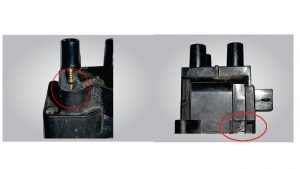

Ignition coil has cracks in body or epoxy resin.
electric current leakage;
Misfire;
Difficulty starting the engine;
Fixing difficulty.
For cause 1, check for abnormal engine vibrations, bearings (cushion) engine support brackets broken or out of specification;
For Cause 2, check any problems in the engine's cooling system. Check that there is no lack of heat deflector or coil spacers and exhaust manifolds. Check that there is no clogging or obstruction of the exhaust and catalyst;
For Cause 3, avoid thermal shocks such as application of cold water when washing engines;
For Cause 4, avoid twisting the coil body during installation;
for all cases, replace the ignition coil with the correct model, referring to the NGK application table.
